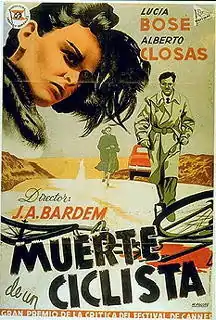Death of a Cyclist
Death of a Cyclist (Spanish: Muerte de un ciclista) is a 1955 social realist Spanish drama film directed by Juan Antonio Bardem and starring Italian actress Lucia Bosè, who was dubbed into Spanish by Elsa Fábregas. It won the FIPRESCI Award at the 1955 Cannes Film Festival.
| Death of a Cyclist | |
|---|---|
 Spanish theatrical release poster | |
| Directed by | Juan Antonio Bardem |
| Produced by | Manuel Goyanes |
| Screenplay by | Juan Antonio Bardem |
| Story by | Luis Fernando de Igoa |
| Starring | Lucia Bosè Alberto Closas |
| Music by | Isidro B. Maiztegui |
| Cinematography | Alfredo Fraile |
| Edited by | Margarita de Ochoa |
Production company | Suevia Films |
| Distributed by | Janus Films |
Release date |
|
Running time | 88 minutes |
| Country | Spain |
| Language | Spanish |
Plot
While returning to Madrid after an illicit tryst, a wealthy socialite housewife and a university professor accidentally strike a bicyclist with their car. Although they see that he is still alive after the accident, they know they cannot summon help for him without their affair being revealed. They drive away and leave him to die. After the bicyclist's death is reported in the newspaper, the pair deal with ever-rising tension, borne from their fear that their deeds will be exposed.
Cast
- Lucia Bosè as María José de Castro
- Alberto Closas as Juan Fernandez Soler
- Otello Toso as Miguel Castro
- Bruna Corra as Matilde Luque
- Carlos Casaravilla as Rafael "Rafa" Sandoval
- Manuel Alexandre as cyclist
Reception
Critical analysis
Film critic Robert Koehler wrote of the director's goals when shooting the film, "With the economy of Tourneur and Walsh, Bardem immediately establishes in the opening frames of Death of a Cyclist not only the incident to which the title refers, but also, more crucially, that lovers Juan (Alberto Closas) and María José (Lucia Bosé) are doomed... The Rafa-María José-Miguel interplay is sprinkled with irony, sarcasm, and suggestion, and comes to a boil with the help of social satire, revenge, paranoia, and suspicion. It’s quite a soup, and Bardem has fun dipping into it. Contrary to the film’s reputation as a stark rebuke of Franco-era hypocrisy and corruption, Death of a Cyclist is perhaps most surprising and memorable for this half-terrifying, half-comical roundelay of three people caught in a web of misunderstanding (María José mistakenly convinced that Rafa witnessed something of the bicycle accident) and distrust (each of them for the other).[1]
Film critic Mark Mesaros discussed the stylistic aspects of the film, writing, "Death of a Cyclist is a polemical tale that borrows the grammar of the Hitchcockian murder mystery as well as the forbidden romance of film noir to achieve its ideologic ends... Beginning with the techniques that are most efficacious, it's necessary to emphasize Bardem's brilliant use of cuts and dissolves throughout. What will be remembered most by viewers is the way the film jump cuts effortlessly between the seemingly primary melodrama and scenes of so-called 'social realism'. At first the cuts are employed between bourgeois and working class milieus, but later more abstract associations will be made. It's apparent that our pair of privileged sinners lie totally outside of 'social reality': when their sports-car hits the cyclist we do not see his twisted frame, only the twisted frame of the bicycle, and the reactions of Juan and María José. Through the course of events Juan will be forced to interlope within the reality of the cyclist and his family, while María José will be further ensconced in the delicate net of her delusion."[2]
American reviews
When first released in the United States in the 1950s, even though the film was hailed in Europe, The New York Times film critic Bosley Crowther panned the film and its style, writing "Aside from the fact that Señor Bardem has not chosen an especially novel theme or given his treatment of it any new or surprising twist, he has actually confused it with weird plotting and a wild, choppy cinematic style. Señor Bardem's cinematic syntax has no capitals or punctuation marks. He jumps from one scene to another without terminal notifications or dissolves. You have to be awfully attentive to figure out where you are...Maybe they have cut this Pathé picture, and the English subtitles are poor. But Señor Bardem will have to do better to make his laurels look deserved."[3]
Awards
Winner, Cannes Film Festival: International Federation of Film Critics (FIPRESCI Prize), Juan Antonio Bardem, 1955
DVD
The film was released in the United States by The Criterion Collection.[4]
References
- Koehler, Robert Archived 2011-01-30 at the Wayback Machine. Cineaste, "A Second Look: Death of a Cyclist," Vol.XXXIV No.3 2009. Last accessed: February 14, 2011.
- Mesaros, Mark Archived 2010-11-23 at the Wayback Machine. Cinelogue: A Catalogue of World Cinema, featured article, July 16, 2010. Last accessed: February 14, 2011.
- Crowther, Bosley. The New York Times, film review, August 19, 1958. Last accessed: February 14, 2011.
- The Criterion Collection web site. Last accessed: February 14, 2011.
External links
- Death of a Cyclist at IMDb
- Death of a Cyclist: Creating a Modern Spanish Cinema an essay by Marsha Kinder at the Criterion Collection
- Death of a Cyclist opening film clip on YouTube by Film-O-Tech (Spain)
- Death of a Cyclist film review by Felicia Feaster at Turner Classic Movies
- Death of a Cyclist film clip on YouTube